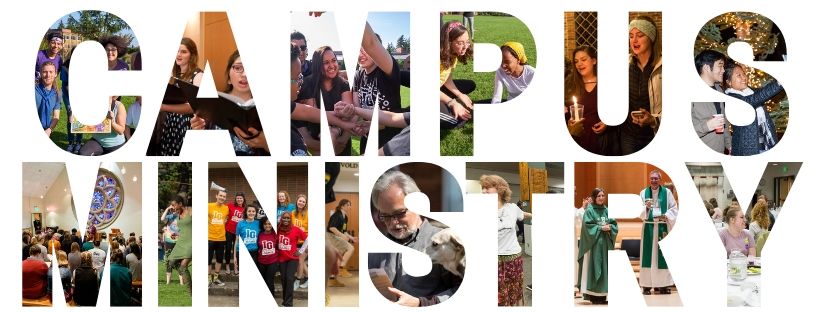Worship During a Pandemic: How COVID-19 Changed Campus Ministry
College chaplains and religious life staff in higher education are transforming their operations to support students during the pandemic
 On my first day in seminary, a professor made one point clear: ministry, as we know it, will have to change in order to survive. The growing number of people unaffiliated with a religious community has set the tone for my seminary education, especially for a religious denomination like my own—the Quakers—that is not known for being mighty in numbers. (Thankfully, Larry the Quaker Oats guy gives us some positive public relations coverage.) Pew Research Center’s Study on the U.S. Religious Landscape found a massive jump in religiously unaffiliated people, from 16.1 percent in 2007 to 22.8 in 2014. The challenge for religious leaders became clear: Americans are growing increasingly dissatisfied with institutional religion. In order to stay relevant, clergy must change with the times. And the necessary changes should take place not only within established congregations, but also on America’s college campuses.
On my first day in seminary, a professor made one point clear: ministry, as we know it, will have to change in order to survive. The growing number of people unaffiliated with a religious community has set the tone for my seminary education, especially for a religious denomination like my own—the Quakers—that is not known for being mighty in numbers. (Thankfully, Larry the Quaker Oats guy gives us some positive public relations coverage.) Pew Research Center’s Study on the U.S. Religious Landscape found a massive jump in religiously unaffiliated people, from 16.1 percent in 2007 to 22.8 in 2014. The challenge for religious leaders became clear: Americans are growing increasingly dissatisfied with institutional religion. In order to stay relevant, clergy must change with the times. And the necessary changes should take place not only within established congregations, but also on America’s college campuses.
Most of the country’s earliest academic institutions were deeply connected to Christian denominations. Harvard was founded in 1636 to educate ministers. The Presbyterian Synod established Princeton with a similar mission to train future clergy. Three Quaker colleges – Haverford (1833), Guilford (1837), and Earlham (1847) – were founded by an Evangelical movement of Friends called the Gurneyite. Clergy at these institutions served as models for ministry and as representative voices for their denomination.
 As the religious landscape of United States started to shift, especially by the middle decades of the twentieth century, so did the role of clergy on college campuses. “Campus ministries” or “Offices of Religious Life,” as they came to be called, worked to support the religious needs of students from diverse religious and ethnic backgrounds. Today, some schools recruit and pay religious leaders to assist in the spiritual life of students, and some also receive funding from local and national organizations to employ staff from diverse religious traditions. The once traditional Protestant-oriented campus ministry office has changed at many institutions to include staff who provide outreach to Muslim students, classes in Buddhist meditation, and Hillel International-funded employees who create opportunities for Jewish students. As the way students engage with religion shifts, so are the religious leaders who are faced with the challenge of supporting college students’ religious needs.
As the religious landscape of United States started to shift, especially by the middle decades of the twentieth century, so did the role of clergy on college campuses. “Campus ministries” or “Offices of Religious Life,” as they came to be called, worked to support the religious needs of students from diverse religious and ethnic backgrounds. Today, some schools recruit and pay religious leaders to assist in the spiritual life of students, and some also receive funding from local and national organizations to employ staff from diverse religious traditions. The once traditional Protestant-oriented campus ministry office has changed at many institutions to include staff who provide outreach to Muslim students, classes in Buddhist meditation, and Hillel International-funded employees who create opportunities for Jewish students. As the way students engage with religion shifts, so are the religious leaders who are faced with the challenge of supporting college students’ religious needs.
Providing care in a crisis
This year, religious leaders who work in higher education faced their biggest challenge yet: supporting students who were no longer on campus. According to a study by Wisdo, college students experienced “an unprecedented spike in depression, anxiety and loneliness” during the first months of the pandemic. It is not difficult to imagine why students had a challenging time. Instead of going on spring break, many students faced the upheaval of moving off campus with limited notice and, in turn, leaving behind the support structures that helped them thrive. Even for students who already lived off campus, this meant no library where they could study, taking classes that were not designed to be online, and having no in-person interaction with their peers. And these stressors occurred amidst the spread of a highly contagious virus. Campus religious leaders had to determine quickly how they were going to support students through grief and anxiety and provide them with a sense of community.
Spirituality is just a click away
When the University of Chicago announced that students would move off campus and courses would take place online, the first thing Jigna Shah, the university’s Assistant Dean of the Rockefeller Chapel and the Director of Spiritual Life, did was review the school’s Spiritual Life website to ensure visibility of online programming and services. During the school year most of their programming took place in the basement of one of the student centers. Now, everything would be equally accessible by the click of a button. Shah and her team changed the categories on their campus page to prioritize resources for students who were experiencing difficulties in the transition to remote learning. Students who wished to speak with a specific campus minister could now go to a Google Calendar on the website to find a Zoom link and the office hours of the campus minister of their choice.
 With physical space no longer available, the way students and staff engaged with one another also had to change. Shah and her team recognized the importance of consistency in online programming. Every weekday, students could join a twenty minute still meditation. Shah worked with her colleagues to set up regular Coffee and Chai Chats where students could bring their beverage of choice to a regular virtual check-in with Spiritual Life staff via Zoom. But even with the consistent programming, students still wanted a calm place to study. During the school year, students would hang out in the public area of the Spiritual Life office and do their homework. To continue this service, Shah and her team created a “Virtual Living Room” to give students the feeling of informal, un-programmed space. Students could keep the Zoom window open and feel like they are studying alongside another person, even from their childhood bedroom.
With physical space no longer available, the way students and staff engaged with one another also had to change. Shah and her team recognized the importance of consistency in online programming. Every weekday, students could join a twenty minute still meditation. Shah worked with her colleagues to set up regular Coffee and Chai Chats where students could bring their beverage of choice to a regular virtual check-in with Spiritual Life staff via Zoom. But even with the consistent programming, students still wanted a calm place to study. During the school year, students would hang out in the public area of the Spiritual Life office and do their homework. To continue this service, Shah and her team created a “Virtual Living Room” to give students the feeling of informal, un-programmed space. Students could keep the Zoom window open and feel like they are studying alongside another person, even from their childhood bedroom.
Do you feel comfortable talking where you are?
The sudden transition to online classes caused an increase in anxiety and depression for many students, and with telemedicine laws limiting access some students have to mental health services, the need to support students was greater than ever. Tammy Liddell, Director of Campus Ministry at Seattle University, has a Masters degree in Counseling from Boston College, but she has always been clear about the difference between providing counseling and pastoral care. Typically, Liddell engages one-on-one with students in her office and recognizes the unique role campus ministry plays at universities. “Students start telling us what’s going on in their lives and why they need to talk to someone who isn’t a peer. That’s what we are: a non-peer conversation partner.” The role of a conversation partner often takes the form of helping students with transitional issues like adjusting to roommates, helping with family problems, and talking about relationships. Campus Ministry staff at Seattle University and other institutions work closely with the school’s counseling center to make sure students get the care and accommodations they need.
Being at home provides new challenges to the conversation partner model of pastoral care. Roommate disagreements are a common problem on college campuses, but what happens when your roommates are also your parents? Confidentiality is also non-existent for many who are living in homes with other people. Liddell and her staff start their Zoom calls with “Do you feel comfortable talking where you are? Does it feel private enough to you?” Normalizing the limits of confidentiality helps students decide if they feel safe having personal conversations about their lives.
Reminding students they are loved
Reverend Jamie Lynn Haskins, the Chaplain for Spiritual Life at the University of Richmond, wears several hats on campus, as many college chaplains do. She’s the faculty advisor to the LGBTQ student group and works closely with students who describe themselves as “spiritual but not religious.” With COVID-19 prompting new needs for students, Haskins worked with the other chaplains to ensure students would have the support they need to grow spiritually and succeed academically during the semester. “I have seen students who never walked through my doors reaching out to me about how do I meditate, or I’m thinking about trying yoga, or do you know anything about Buddhism?” For some students, however, the time at home brought up challenges that they thought they had left behind. Haskins’s schedule now consists of multiple mini-meetings to touch base with students. The school’s counseling center continues to be a resource for students who need more mental health care, but for many students the consistency of regularly checking in with a chaplain has provided relief.
When asked what spiritual support for LGBTQ students looks like during the pandemic, Haskins replied, “College is this time of radical discovery. And so you’ve got freshmen who are just dipping their toes into like, ‘Oh, my God, I’m queer. And no one knows, but I’m going to be out here at the University of Richmond because I don’t know anyone.’ And they did that for like seven months. And now they’re just super back in the closet.” She also added, “And you’ve got these seniors who have done four years of just beautiful work–like they’re so out. And they’ve claimed all their spaces and they are there. But now they’re having to go home and not always, but often that work is not supported at home, particularly if it’s fraught…. And so I’ve just tried to be an incredibly loud voice. I mean, I could never overpower a mom who won’t use [correct] pronouns or a dad who won’t believe you’re coming out. But I just try to speak as often and as loudly as I can. I love you. And if you believe in God, God loves you. I promise. I promise. I promise.” Haskins knows she cannot control the circumstances many LGBTQ students face, but providing love and affirmation from a religious figure who validates their identity is something she can do from her computer.
Practicing religion in community
 For many students, religion is about community, celebrating holidays together, and feeling a connection with others who share similar interests. When the pandemic threatened to leave student feeling isolated, the staff at Hendricks Chapel at Syracuse University changed how they provide students with a religious community. Friday prayers for Muslim students had been a way for Syracuse students to practice their faith and come together weekly. Amir Duric, the Muslim chaplain at Syracuse University, recognized the immediate need to bring this community online and expand it. Duric started a new program called “Spiritual Sitdowns” for students to discuss current events. He says, “Spiritual Sitdowns bring together not just students, but also recent graduates and people from all over the world. It became one coherent group of recent graduates and students. I wanted to create a safe space where they could share how they feel and what we were able to navigate together.” Originally Duric thought this program would end after the spring semester, but after receiving requests from students he is continuing through the summer and starting to figure out how to keep the group going online and in-person in the fall.
For many students, religion is about community, celebrating holidays together, and feeling a connection with others who share similar interests. When the pandemic threatened to leave student feeling isolated, the staff at Hendricks Chapel at Syracuse University changed how they provide students with a religious community. Friday prayers for Muslim students had been a way for Syracuse students to practice their faith and come together weekly. Amir Duric, the Muslim chaplain at Syracuse University, recognized the immediate need to bring this community online and expand it. Duric started a new program called “Spiritual Sitdowns” for students to discuss current events. He says, “Spiritual Sitdowns bring together not just students, but also recent graduates and people from all over the world. It became one coherent group of recent graduates and students. I wanted to create a safe space where they could share how they feel and what we were able to navigate together.” Originally Duric thought this program would end after the spring semester, but after receiving requests from students he is continuing through the summer and starting to figure out how to keep the group going online and in-person in the fall.
Duric is already starting to consider the logistics of prayer on campus if students return this fall. “How many students would be able to participate in that? Are we going to have to have two or three services that we don’t pass that limit or what is going to be limited? And then usually when we pray, we stand next to each other. But some mosques are resuming prayers now and they now, which was never the case, are praying six feet away from each other while it was always shoulder to shoulder. It’s just the new reality. We have to adjust to it.”
Academic institutions are changing – and so is campus ministry
Religious life on campuses will continue to change, as will higher education. When asked about the way campus ministry will transform after the pandemic, Rev. Brian E. Konkol, the Dean of Hendricks Chapel at Syracuse University replied, “The crisis has compelled us to just move a bit quicker, to catch up and create opportunities. We have students who would have much rather connected online. And we’ve had students taking online classes for years. We all can recognize that this [pandemic] is clearly a terrible situation, but Hendricks Chapel is far more than a beautiful physical structure that we put on postcards. It represents a movement and service to the common good that knows no boundaries.”
Students returning to campus this fall, either online or in-person, will find a different religious life experience than the one they saw one year ago. Every religious leader working in higher education I met shared the same message: there is no going back to the way things were before the pandemic.
Campus ministries have changed remarkably in the past several decades to meet the needs of religiously, culturally, and sexually diverse student populations. The lessons learned in the pandemic have become the blueprint for how to meet the needs of college students in the twenty-first century. The pandemic may have changed our world, but for religious leaders struggling to serve a broader community, these changes may only be the beginning of what is to come. Indeed, these changes may be the only way for institutional religious leaders to stay relevant in this new religious landscape.
Katie Breslin is a writer and seminary student at Earlham School of Religion, where she is studying Quaker Ministry. Previously, she worked in faith-based advocacy at the Friends Committee on National Legislation (FCNL) and Catholics for Choice. You can find her writing at katiebreslin.com and follow her on twitter @katiebreslin.